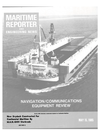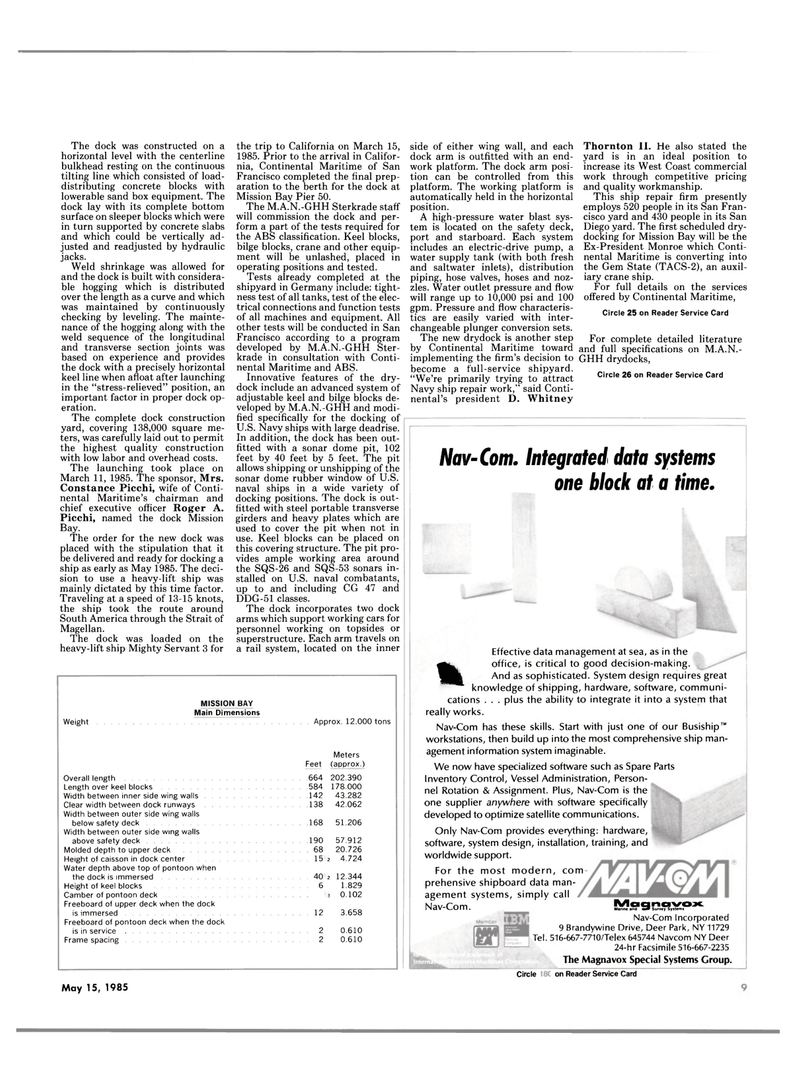
Page 7: of Maritime Reporter Magazine (May 15, 1985)
Read this page in Pdf, Flash or Html5 edition of May 15, 1985 Maritime Reporter Magazine
The dock was constructed on a horizontal level with the centerline bulkhead resting on the continuous tilting line which consisted of load- distributing concrete blocks with lowerable sand box equipment. The dock lay with its complete bottom surface on sleeper blocks which were in turn supported by concrete slabs and which could be vertically ad- justed and readjusted by hydraulic jacks.
Weld shrinkage was allowed for and the dock is built with considera- ble hogging which is distributed over the length as a curve and which was maintained by continuously checking by leveling. The mainte- nance of the hogging along with the weld sequence of the longitudinal and transverse section joints was based on experience and provides the dock with a precisely horizontal keel line when afloat after launching in the "stress-relieved" position, an important factor in proper dock op- eration.
The complete dock construction yard, covering 138,000 square me- ters, was carefully laid out to permit the highest quality construction with low labor and overhead costs.
The launching took place on
March 11, 1985. The sponsor, Mrs.
Constance Picchi, wife of Conti- nental Maritime's chairman and chief executive officer Roger A.
Picchi, named the dock Mission
Bay.
The order for the new dock was placed with the stipulation that it be delivered and ready for docking a ship as early as May 1985. The deci- sion to use a heavy-lift ship was mainly dictated by this time factor.
Traveling at a speed of 13-15 knots, the ship took the route around
South America through the Strait of
Magellan.
The dock was loaded on the heavy-lift ship Mighty Servant 3 for the trip to California on March 15, 1985. Prior to the arrival in Califor- nia, Continental Maritime of San
Francisco completed the final prep- aration to the berth for the dock at
Mission Bay Pier 50.
The M.A.N.-GHH Sterkrade staff will commission the dock and per- form a part of the tests required for the ABS classification. Keel blocks, bilge blocks, crane and other equip- ment will be unlashed, placed in operating positions and tested.
Tests already completed at the shipyard in Germany include: tight- ness test of all tanks, test of the elec- trical connections and function tests of all machines and equipment. All other tests will be conducted in San
Francisco according to a program developed by M.A.N.-GHH Ster- krade in consultation with Conti- nental Maritime and ABS.
Innovative features of the dry- dock include an advanced system of adjustable keel and bilge blocks de- veloped by M.A.N.-GHH and modi- fied specifically for the docking of
U.S. Navy ships with large deadrise.
In addition, the dock has been out- fitted with a sonar dome pit, 102 feet by 40 feet by 5 feet. The pit allows shipping or unshipping of the sonar dome rubber window of U.S. naval ships in a wide variety of docking positions. The dock is out- fitted with steel portable transverse girders and heavy plates which are used to cover the pit when not in use. Keel blocks can be placed on this covering structure. The pit pro- vides ample working area around the SQS-26 and SQS-53 sonars in- stalled on U.S. naval combatants, up to and including CG 47 and
DDG-51 classes.
The dock incorporates two dock arms which support working cars for personnel working on topsides or superstructure. Each arm travels on a rail system, located on the inner
MISSION BAY
Main Dimensions
Weight .... Approx. 12.000 tons
Meters
Feet (approx.)
Overall length . . . .664 202.390
Length over keel blocks . . . .584 178.000
Width between inner side wing walls . . . .142 43.282
Clear width between dock runways . . . .138 42.062
Width between outer side wing walls below safety deck . . . .168 51.206
Width between outer side wing walls above safety deck . . . .190 57.912
Molded depth to upper deck . ... 68 20.726
Height of caisson in dock center . ... 15 2 4.724
Water depth above top of pontoon when the dock is immersed .... 40 2 12.344
Height of keet blocks . . . . 6 1.829
Camber of pontoon deck 3 0.102
Freeboard of upper deck when the dock is immersed . ... 12 3.658
Freeboard of pontoon deck when the dock is in service . . . . 2 0.610
Frame spacing . . . . 2 0.610 side of either wing wall, and each dock arm is outfitted with an end- work platform. The dock arm posi- tion can be controlled from this platform. The working platform is automatically held in the horizontal position.
A high-pressure water blast sys- tem is located on the safety deck, port and starboard. Each system includes an electric-drive pump, a water supply tank (with both fresh and saltwater inlets), distribution piping, hose valves, hoses and noz- zles. Water outlet pressure and flow will range up to 10,000 psi and 100 gpm. Pressure and flow characteris- tics are easily varied with inter- changeable plunger conversion sets.
The new drydock is another step by Continental Maritime toward implementing the firm's decision to become a full-service shipyard. "We're primarily trying to attract
Navy ship repair work," said Conti- nental's president D. Whitney
Thornton II. He also stated the yard is in an ideal position to increase its West Coast commercial work through competitive pricing and quality workmanship.
This ship repair firm presently employs 520 people in its San Fran- cisco yard and 430 people in its San
Diego yard. The first scheduled dry- docking for Mission Bay will be the
Ex-President Monroe which Conti- nental Maritime is converting into the Gem State (TACS-2), an auxil- iary crane ship.
For full details on the services offered by Continental Maritime,
Circle 25 on Reader Service Card
For complete detailed literature and full specifications on M.A.N.-
GHH drydocks,
Circle 26 on Reader Service Card
Nav-Com. Integrated data systems one block at a time.
Effective data management at sea, as in the m office, is critical to good decision-making.
And as sophisticated. System design requires great knowledge of shipping, hardware, software, communi- cations . . . plus the ability to integrate it into a system that really works.
Nav-Com has these skills. Start with just one of our Busiship™ workstations, then build up into the most comprehensive ship man- agement information system imaginable.
We now have specialized software such as Spare Parts
Inventory Control, Vessel Administration, Person- nel Rotation & Assignment. Plus, Nav-Com is the one supplier anywhere with software specifically developed to optimize satellite communications.
Only Nav-Com provides everything: hardware, software, system design, installation, training, and worldwide support.
For the most modern, com prehensive shipboard data man- agement systems, simply call
Nau-frim Maqnavox IN CIV V U! I I Marine and Survey Systems
Nav-Com Incorporated 9 Brandywine Drive, Deer Park, NY 11729
Tel. 516-667-7710/Telex 645744 Navcom NY Deer 24-hr Facsimile 516-667-2235
The Magnavox Special Systems Group.
Circle 245 on Reader Service Card
May 15, 1985 39

 6
6

 8
8
